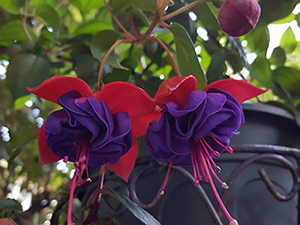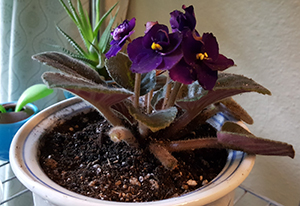
 |
Haworthia (Zebra Succulent)Haworthias are small succulent plants, forming rosettes of leaves. These rosettes are usually stemless, but in some species stems reach up to 20 inches. The plants can grow solitary or can be clump-forming. Most species have firm, tough, fleshy leaves, usually dark-green in color with lighter colored bands (giving the plant its nickname of zebra succulent). CareLike all succulents, Haworthias should be planted in cactus mix or very fast-drying potting soil mixed with sand. Haworthias prefer bright light, but not direct sunlight. They grow well in similar conditions to other succulents. White or yellow leaves usually indicate too much sun. Water evenly and generously in the summer, letting the soil media dry out between watering. In the winter, reduce watering to every other month. Never allow water to collect in the rosette. |
Fuchsia There are approximately 110 species of fuchsia recognized. Most fuchsia are shrubs, but one New Zealand species is a tree. Fuchsia leaves are opposite or in whorls of three to five, simple lanceolate, and usually have serrated margins. Fuchsia can either be deciduous or evergreen depending on the species. The flowers are very decorative; they have a pendulous 'teardrop' shape and are in protrusion throughout the summer and autumn. CareMost fuchsias like to be in a shady location, either no sun or morning sun only. Fuchsias can be planted a little deeper than the soil line, but never allow any leaves beneath the soil, pick them off and discard. Fuchsias grown in baskets or containers need extra care with watering. A full grown plan needs to be watered daily. On really hot days, some may need to be watered twice a day. |
African Violet African violets are herbaceous perennial flowering plants that can be either indoor or outdoor depending on climate. The leaves are rounded to oval, finely hairy, and have a fleshy texture. The flowers are five-lobed velvety petals and grow in clusters of 3-10 or more on slender stalks. Wild species can have violet, purple, pale blue, or white flowers. African violets are highly sensitive to temperature changes, especially rapid leaf cooling. CareAfrican violets do best in specialized soil specifically for them. They are very picky about water. Water with tepid or luke-warm water that has set for 48 hours. Water at the base, never splash the foliage of the plant with water. Water when soil feels less moist to the touch. Never let African violets stand in water or completely dry out. Provide with filtered light. Place African violets three feet from a south- or west-facing window for the right lighting. |